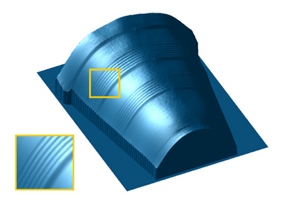Some exciting research out of MIT promises to make cheap consumer scanners as precise as laser scanners.
According to MIT News this breakthrough was made possible by “exploiting the polarization of light,” which enables researchers to increase the resolution of consumer 3-D imaging devices “by as much as 1,000 times.” They say the technique could lead to high-quality 3D cameras in cellphones. (We’ve been hearing that one for years, but… maybe it’s true this time?)
In what must be the most adorable passage about optics that I have ever read, MIT explains how the technology works:
“If an electromagnetic wave can be thought of as an undulating squiggle, polarization refers to the squiggle’s orientation. It could be undulating up and down, or side to side, or somewhere in-between.”
The polarization of light, or the way the “squiggle undulates,” affects how it reflects off of an object. If light hits an object straight on, not much is reflected. However, if it hits an object at a weird angle, only certain polarizations of light are reflected. What’s more, the polarization of light reflected changes depending on the angle.
This means that if we measure the polarization of reflected light, we can gather “information about the geometry of the objects it has struck.”
Unfortunately, each particle of light offers two “equally plausible hypotheses” about the object’s angle of orientation. That’s no good. Given a few million points, you’d be calculating forever.
However, the researchers found that by comparing the polarization data with some coarse time-of-flight data (like you get from an Xbox Kinect sensor), they were able to zero in on the orientation faster. This is possible because the time-of-flight data gives a rough idea of the shape of the object, enough to eliminate one of the two orientation possibilities offered by each piece of polarization data. At that point, the shape of the object is easy enough to calculate that even the graphics chip in an Xbox can handle it.
The upshot is that we’re possibly, finally, actually within spitting distance of an honest-to-goodness cell phone 3D sensor that’s good enough to use for precise measurement.
“The work fuses two 3-D sensing principles, each having pros and cons,” says Yoav Schechner, an associate professor of electrical engineering at Technion — Israel Institute of Technology in Haifa, Israel. “One principle provides the range for each scene pixel: This is the state of the art of most 3-D imaging systems. The second principle does not provide range. On the other hand, it derives the object slope, locally. In other words, per scene pixel, it tells how flat or oblique the object is.”
“The work uses each principle to solve problems associated with the other principle,” Schechner explains. “Because this approach practically overcomes ambiguities in polarization-based shape sensing, it can lead to wider adoption of polarization in the toolkit of machine-vision engineers.”
I’ll believe it when I see it, but I’m excited nonetheless. For more of the science behind this breakthrough, check out MIT news, or the paper behind it all.






